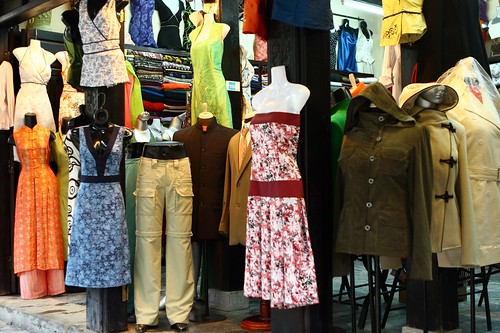Your moment has finally arrived! Your slightly blinded by the flashing lights as you stop at the end of the runway, and take a bow. The people of the press are literally falling over to get a statement about your latest collection. High profile celebrities, and their stylists are front row applauding your breath taking pieces and...(pop!)....Sorry to be the one to bust your bubble, but there are certain aspects to be considered before you get anywhere near this status.
A lot of people feel they have what it takes to create an apparel line, but at the end of the day many of them lack the general knowledge of the business end of the venture. Sure, you may have adorable dresses or denim, but there are certain steps that need to be implemented in order to be a success. In this diary entry I will give you a comprehensive guide as to what it takes to create an apparel line from the product development end.
Styling- How are your products going to be merchandised? Do you know will the actual flow of your line be? Will you specialize in related separates or suits? How will your products be presented before the targeted consumer? Do you have a clear brand image you want to create in your customers mind? The answer to that question should have automatically been a yes, because branding is essential to your line's development.
Sizes-What are your limits as far as sizes go? Will you be offering basic sizes or specializes size groups such as Petities, Petitie-Plus, and or general plus sizes only? This is an important factor because it can have an effect on your overall costs. The bigger the sizes mean more fabrication, and the wider the size range the more likely it will cost to produce your product line.
Samples-Who will be making your samples/prototypes, and what is your sample size? Do you have an ideal fit model/dress form to fit the samples to. Getting the sample just right may take a couple of tries, and this can add as far as cost so be sure to be careful at this stage. It is very easy for your time and money to get tied up into counter samples, especially if trust someone else is handling that aspect. Thoroughly researching manufacturers, pattern makers, and or seamstresses will be help prevent major losses in the long run.
Fabrication-What types of fabric will your line consist of? Will your line offer all natural, synthetic, blends or all of the above? It is imperative that you understand this importance of this aspect simply because fabrics can be costly, thus making the product pricing more complex. I advise you to heavily research this area before you jump the gun, and invest in any fabric.
Price Points-Production costs, fabrications, shipping, and sourcing are all aspects that add into the cost of your product line. Your price point should cover these costs, and all a little room for profit. Though the idea is to make a profit, your price points should be in a reasonable range of what your target consumer is willing to pay for your products. After you research your target consumer, I suggest you create a base line price scale as a guide during your product development process.
Location, Location, Location- How will you present your product? Who will be carrying your products? Will you have your own boutique, or do you plan on selling exclusively online, or local boutiques and specialty shops? Remember this is extremely important as you develop your products, because you overhead costs should be accounted for when buffering out your pricing,
As you can see, there is a lot to consider when it comes to starting an apparel line. If you can fluidly answer the questions above then you are well on your way, if not I suggest you do your research. The purpose of this entry is not to defer people from launching their own lines, but to inform them about the long process that comes with it. Its okay to dream, but at some point in time you have to be realistic about your ideas as well. My next diary entry will go more into depth about the product development process so stay tuned!
Fashionably yours,








3 comments:
I totally agree with you that Fashion design is not just about apparal, there is a business part to it and many have yet to see that part.
I read this book 'Fashion- designer survival guide'. It talks about most of what you have mentioned above. Do check it out if you can.
God bless!
UmaPreve
Hello Uma! I have not read that book, I will be sure to check it out thanks for the referral, and im glad you already have the patternmaking book that saves $$ lol, I am currently working on my Fall 2010 collection, and I will be sure to let you know of any other patternmaking resources I may find along the way!
Keep me in this loop as well! Very good and useful information.
Post a Comment
Say whats on your mind, we'd love to know!